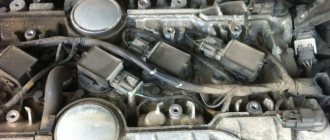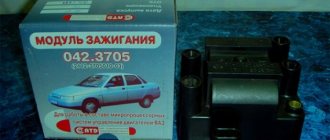The 1.6-liter 16-valve VAZ 21126 engine appeared in 2007 along with the Lada Priora and then spread to almost the entire model range of the Russian company AvtoVAZ. This unit was also often used as a blank for the concern’s sports engines.
The VAZ 16V line also includes: 11194, 21124, 21127, 21129, 21128 and 21179.
- Characteristics
- Description
- Consumption
- Application
- Reviews
- Service
- Breakdowns
- Prices
Technical characteristics of the VAZ 21126 1.6 16kl engine
| Type | in-line |
| Number of cylinders | 4 |
| Number of valves | 16 |
| Exact volume | 1597 cm³ |
| Cylinder diameter | 82 mm |
| Piston stroke | 75.6 mm |
| Supply system | injector |
| Power | 98 hp |
| Torque | 145 Nm |
| Compression ratio | 10.5 — 11 |
| Fuel type | AI-92 |
| Environmental standards | EURO 3/4 |
| Type | in-line |
| Number of cylinders | 4 |
| Number of valves | 16 |
| Exact volume | 1597 cm³ |
| Cylinder diameter | 82 mm |
| Piston stroke | 75.6 mm |
| Supply system | injector |
| Power | 114 - 118 hp |
| Torque | 150 - 154 Nm |
| Compression ratio | 11 |
| Fuel type | AI-92 |
| Environmental standards | EURO 4/5 |
| Type | in-line |
| Number of cylinders | 4 |
| Number of valves | 16 |
| Exact volume | 1597 cm³ |
| Cylinder diameter | 82 mm |
| Piston stroke | 75.6 mm |
| Supply system | injector |
| Power | 136 hp |
| Torque | 154 Nm |
| Compression ratio | 11 |
| Fuel type | AI-92 |
| Environmental standards | EURO 5 |
The online manual for this engine is here
The engine is briefly described in an article on ZaRulem
For such a unit there are also forged pistons
Design features of the Lada 21126 16 valve engine
The main difference between this internal combustion engine and its predecessors is the widespread use of foreign components in the assembly. First of all, this concerns a lightweight connecting rod and piston group manufactured by Federal Mogul, as well as a timing belt with an automatic tensioner from Gates.
Due to the strict requirements of the American company, the manufacturer of ShPG, additional procedures are carried out on the conveyor for processing the surfaces of the block, as well as honing the cylinders. There were also some disadvantages here: new pistons without holes made the power unit plug-in. Update: from mid-2022, the engines received an update in the form of plugless pistons.
Otherwise, everything is familiar here: a cast-iron block, which traces its history back to the VAZ 21083, a 16-valve aluminum head with two camshafts, standard for VAZ products, the presence of hydraulic compensators eliminates the need to adjust the valve clearances.
The video shows the consequences of a broken timing belt and subsequent head repair
The car engine 21126 is a four-stroke four-cylinder engine installed on a VAZ 2170 car. Fuel injection is distributed, the camshaft is located at the top. The VAZ 21126 engine is equipped with a liquid cooling system, closed type, coolant circulation is forced. The lubrication system is combined (spraying and under pressure).
To change gears, the Lada Priora is equipped with a five-speed gearbox.
The 126 engine has the following technical characteristics:
- Cylinders with a volume of 1.6 liters.
- The compression ratio is 11.
- Rated power is 98 horsepower.
- Priora engine 16 valves.
- Fuel is supplied by electronically controlled distributed injection.
- The sixteen valve engine weighs 115 kg.
Diagnostics using a computer
If your car is equipped with a modern control unit, then this greatly simplifies troubleshooting; otherwise, you will have to use time-tested old-fashioned methods.
By connecting the computer to the car, you can find out in which cylinder, 1, 2, 3 or 4, and for what reason there are misfires, for example, the ignition coil or one of the injectors has failed.
But in any case, before going to a car service center, you need to check the condition of the spark plugs, injectors, high-voltage wires, how the exhaust system works, and whether there is smoke from the exhaust pipe.
Many car owners cannot afford instruments for car diagnostics, these include scanners (software and portable), motor testers, oscilloscopes, gas analyzers and other devices, and you need to be able to use them, read error codes, and so on. Although if you look into it, there is nothing complicated there.
The scanner is connected to a special connector, which can be located in different places in each car model, but it has one function: diagnostics.
Next, error codes are read from the control unit and decrypted.
For example, VAZ 2110, 2114, 2115, Lada Kalina, Priora, Granta cars have the following error codes that are characteristic of misfire:
- P0300 - a large number of misfires;
- P0301, P0302, P0303, P0304 – misfires in cylinders 1, 2, 3 and 4, respectively;
- P0300 - a large number of misfires in a random order;
- P0301, P0302, P0303, P0304 – misfires were detected in 1, 2, 3 and 4, respectively;
- P0363 – see point 4 + fuel supply to problem cylinders is stopped;
- P1301, P1302, P1303, P1304 – respectively, misfires dangerous for the catalytic converter were detected in cylinders 1, 2, 3, 4;
- P0300, P0301, P0302, P0303, P0304 – detection of misfires affecting the toxicity of exhaust gases;
- P0363, P1301, P1302, P1303, P1304 – the same as in point 7, but affecting the catalyst;
- P0351, P0352, P0353, P0354 – open circuit in the ignition coil in the control circuit 1 (1-4), 2 (2-3), 3, 4;
- P2301 P2303 P2305 P2307 - short to on-board network in the coil in the control circuit of cylinders 1 (1-4), 2 (2-3), 3, 4;
- P0201, P0202, P0203, P0204 – respectively, open circuit for controlling injectors 1,2,3,4;
- P0261, P0264, P0267, P0270 - short circuit of the injector control wires to the body, respectively, in the 1st, 2nd, 3rd, 4th center;
- P0262, P0265, P0268, P0271 – the same as point 12, but only to the on-board network;
- P1500 – electric fuel pump relay, wire break.
Read more about how to diagnose a car using a laptop.
Diagnostics of VAZ 2109, 2110, 2114, 2115, Kalina, Priora, Granta
Let's look at misfires using the example of the VAZ 2109, 2110, 2114, 2115, Kalina, Priora, Granta models.
The computer generated error P0303 (misfire in 3rd crank).
First you need to understand how the ignition coil works. It consists of two small coils, pins 1 and 4 are connected to the first, and pins 2 and 3 to the second.
Those. during operation, voltage is simultaneously supplied to the first and fourth cylinders or to the second and third.
We have misfires in cylinder 3. Remove the wires from 2 and 3 and swap them.
Start the engine and see if the error has moved to cylinder 2, then the problem is most likely in the high-voltage wires or in the coil itself, and they need to be checked first.
High-voltage wires are tested by checking their resistance. To do this you need a regular multimeter.
Set the resistance measurement mode to 20 kOhm.
In our case, we check the third wire. If the device shows numbers within the range of 3.5 - 10 kOhm, then the wire resistance is considered normal, otherwise it changes.
Next we check the coil. For this you will also need a multimeter.
We measure the resistance between 1 and 4 and 2 and 3 coil terminals. Readings of 10 kOhm, or around this figure, are considered standard.
Important. During testing, the tester should not show 1. This means that there is an open circuit in the circuit and the coil is faulty.
Next we check the resistance between each terminal and ground. In this case, on the contrary, the multimeter should show 1 (infinity).
If resistance is shown at one of the terminals, it means that its insulation is damaged and it is connecting to ground. Accordingly, the required voltage will not be supplied to form a spark.
Next, we check the resistance between the central terminal of the ignition coil and the housing (ground). It should also be equal to infinity, i.e. 1.
Now it remains to check the resistance between the extreme terminals. To do this, set a different measurement limit on the device - 200 Ohms.
A resistance of 2 ohms is considered normal (+-). There should be no break between the extreme terminals.
Next, check the condition of the contacts on the coil itself and on the wires; they tend to oxidize over time, especially if your region of residence has a humid climate.
If the error remains in cylinder 3, but the coil and high-voltage wires are in good condition, we check the spark plug.
The easiest option is to remove the spark plug from the working cylinder and swap them.
If the error then transferred to another cylinder, then most likely the issue is in the spark plug.
If nothing has changed and the error remains, then check the injectors.
In this case, you also need a multimeter. Disconnect the wires from the injector, in our case from cylinder 3, and measure the resistance, it should be about 13 ohms.
Next, check the injector power supply circuit. Also, the injector may become clogged and not supply the required amount of fuel, which can cause misfires. Therefore, you will have to clean the injectors.
If after all the above checks the misfires have not disappeared, you need to check the valve clearances.
The valves should not be tightly clamped, as this will lead to their incomplete closing, and this, in turn, will lead to a decrease in compression and compression ratio in the cylinders and this will cause misfires. Also, if you press too hard, the valve may burn out.
Especially the condition of the valves should be paid to owners of cars with LPG, since the combustion temperature of gas there is slightly higher than gasoline and therefore the thermal clearances of the valves in this case should be slightly larger, i.e. not 0.2, but 0.25 mm. And where is 0.3, then 0.35 mm (for the above models).
READ ON THE TOPIC: Other characteristic malfunctions of the VAZ 2110 and other cars in the series.
BMW x5 e53 engine m54 3.0 USA
If we talk about foreign cars, they also have special error codes indicating misfires.
Let's look at the error codes using the example of a BMW x5 e53 motor M54 3.0 USA (if the country of manufacture is different, the codes may differ).
As a rule, these errors are associated with problems with mixture formation, sparking and decreased compression:
- Problems with the ignition coil - errors 101, 202, 303, respectively, cylinders 2, 4, 6;
- Injector circuits – errors 505, 606, short circuit, open circuit;
- Injector - codes 2216, 2317, 2418, 3321, respectively, refer to cylinders 3, 6, 4, 5;
- Malfunction of the idle air control valve - 271V;
- Ignition coil - errors 291D, 301E, 311F - 1, 3, 5 ts.
- Problems with the camshaft position sensor - error code 6541;
- Fuel pump relay - error code 6945;
- Problems in the ignition system - 210D2;
- Failure of the idle air control valve as a result of its mechanical damage - 211D3;
- Poor quality fuel mixture - 227E3 for cylinders 1, 2, 3 and 228E4 for 4, 5, 6.
- Cylinder misfires - 238EE in the first, 239EF in the second, 240F0 in the third, 241F1 in the fourth, 242F2 in the fifth, 243F3 in the sixth;
- Weak flow in the air mixing system - 245F5 cylinders 1, 2 and 3. Error code 246F6 - 4, 5 and 6 cylinders.
Also, the reasons for misfire in a BMW x5 e53 M54 engine can be:
- Air leakage, for example, the throttle corrugation or other suction points are torn;
- The mass air flow sensor has failed;
- Incorrect operation of hydraulic compensators;
- Timing chain stretching and ignition timing deviation;
- The high-voltage coil of one of the cylinders has failed (rearrange it to check);
- The problem is in the flow meter, remove the terminal block from it and see how the engine works;
- If the BMW x5 e53 has misfires after 3000 rpm, then check the DIS (DISA - installed inside the intake manifold, designed to suck in the fuel mixture through separate pipelines);
- A failed membrane is responsible for the mixture of gasoline and air;
- Other reasons.
Factors affecting the service life of the VAZ 2170
According to the manufacturer, the ICE 21126 with sixteen valves has a stable operation duration of 200 thousand kilometers. After a certain mileage it is necessary to carry out major repairs. Taking good care of the VAZ 2170, proper maintenance (MOT) and timely replacement of damaged components and parts will lead to a long service life of the vehicle.
Reasons affecting the service life of the power unit:
- Engine overheating. Elevated temperatures of a running engine negatively affect the overall service life of the motor. Maintaining the operating temperature of the power unit elements at a constant level significantly extends its operating time.
- Fuel. The vehicle's owner's manual contains detailed information about the recommended brand of gasoline. Filling the 16-valve Priora engine with fuel must be of proven quality.
- Machine oils. Which oil is best to fill, its brand and how much lubricant is needed is indicated in the accompanying documentation for the car. The 126 sixteen valve engine accepts semi-synthetic and synthetic motor oils most well. A complete oil change should be carried out annually or after a mileage of 15 thousand kilometers.
The optimal operating engine temperature is 90 - 95 °C. The rules allow the power unit to operate at temperatures reaching up to one hundred degrees, provided that the radiator fan is running. The engine temperature is considered low if it is below +90°C. In cold weather, it takes more time to warm up the engine to the desired mark on the device.
When servicing your VAZ 2107 car, the car owner can change the oil with his own hands. To do this, you need to know how to drain used lubricating fluid, what kind of oil to pour into the Priora and how much engine oil to pour into the neck.
Are the valves bending?
In Lada Priora cars, even in a 16-valve 126 power unit, valves can often bend. The reasons causing this defect lie in non-compliance with operating rules, in case of violation of the regulations for replacing the following components and parts:
- rollers;
- timing belt;
- water pump.
If one of the listed components breaks down, the pistons, exerting mechanical stress on the valves, can bend them. The design features of the engine are the reasons why the engine can bend valves. Deformation of the valves necessitates a major overhaul of the Priora engine.
To avoid this defect, the car owner needs to timely check the timing elements. Of particular importance is the belt, which is subject to thorough inspection after 50 thousand kilometers. When checking, the following faults are excluded:
Why does the engine stall?
Frequently encountered breakdowns of this power unit include such defects as unstable operation and engine tripping. Such failures occur due to malfunctions in engine components and parts:
- decrease in fuel pressure;
- defects in gas distribution mechanism elements;
- sensor malfunctions;
- violation of tightness in hoses;
- faulty throttle valve.
The power of the power unit is reduced for the following reasons:
- low compression in one or more cylinders;
- burnout of gaskets;
- wear of cylinder walls;
- erasing piston rings;
- deformation of pistons under the influence of high temperatures.
Engine friction can be eliminated by flushing the injectors. The reasons for unstable operation of the power unit may lie in the malfunction of the following devices:
- spark plugs for Priora 16 valves;
- ignition coil;
- throttle valve;
- idle air control;
- battery;
- starter;
- ignition coil;
- gasoline pump;
- fuel filter;
- fuel pressure regulating device.
You can replace the spark plugs on Priora yourself. To do this, you need to familiarize yourself with the principles of correct selection and replacement of these nodes, described in special articles on the Internet.
Malfunctions
Despite various upgrades, the engine in the VAZ 21127 retained all the faults of its predecessor, the main ones of which are shown in the table:
| FAULT | CAUSE |
| The engine starts to stall | Coking of injectors. |
| Malfunction of ignition coils. | |
| Reduced compression. | |
| Cooling system overheating | Thermostat malfunction. |
| Formation of a mud coat as a result of oil leakage. | |
| Knocks and noises at the top of the engine | Malfunctions of hydraulic valve compensators |
| Knocks at the bottom of the engine | Main bearing wear |
| Knocks in the middle of the engine | Connecting rod bearings and piston pin faults |
| Bend cylinder head valves | Belt drive slipping through gear tooth |
| Interruptions and startup problems | Violations in the operation of the timing belt. |
| Malfunctions in the fuel pressure system. | |
| Air leak. | |
| Broken throttle valve. | |
| Sensor malfunction. | |
| Power reduction | Burnt out timing head gasket. |
| Burnout of pistons, wear of rings and cylinders. |
Priora engine tuning
To improve the power performance of the Priora power unit, they resort to the following modifications:
- The receiver is installed.
- Exhaust pattern: 4-2-1.
- Throttle valve: 54 -56 mm.
- Sports camshaft.
- Modification of the cylinder head (cylinder head) by sawing.
- Lightweight valves.
- 440cc type injectors.
In addition to the considered method of transforming the power unit to increase dynamic performance, there are several more ways to tune a car of this model.
Four-cylinder internal combustion engines of the 126 series are installed on Lada Priora cars and their modifications produced by the famous AvtoVAZ company. The 126 engine belongs to the category of four-stroke engines, is equipped with a distributed fuel injection system, the camshaft is located in the upper part. The power unit is equipped with a liquid cooling system. Coolant circulates inside a closed system under pressure. The functioning of the 21126 motor lubrication system is based on splashing and supplying fluid under pressure.
Engine Features 126
The development of the 21126 internal combustion engine was carried out in parallel with the VAZ-21124 internal combustion engine. With different working volumes of the models, a large number of coincidences were noted for the incoming systems and nodes. The main task before the creators of the 21126 engine was to obtain the most durable mechanism, characterized by a long service life.
The elements of the connecting rod and piston group were developed by Federal Mogul. The company's engineering team created a design that compares favorably in weight (30% lighter) with a similar kit installed on the 2110 machine.
In terms of external parameters, the engines of variants 124 and 126 are very similar, but there are certain differences between them. What is the difference between a 124 engine and a 126:
- The pistons of the 126 engine have less mass.
- The height of the block is 197.1 mm, while the diameter of the cylinders themselves has not changed.
- The inner walls of the cylinders are processed by honing using high technologies from Federal Mogul, which significantly improves their quality in comparison with analogues.
- The piston rings and pins are reduced in thickness, which also helps improve the power and speed characteristics of the motor (torque, efficiency, etc.).
- The cylinder block of the 126 engine is painted in a characteristic gray color, making it easy to distinguish from the 124 model.
In the Priora 126 engine, the ducts of the cylinder cooling jacket run along the entire height of the block. With this arrangement of channels, the degree of deformation of the body part is significantly reduced due to uneven exposure to ultra-high temperatures.
Important: Cars equipped with a 126 engine pick up speed faster. When tuning yourself, it is recommended to install brake system elements (pads, air-vented discs) that have the best quality and greatest efficiency.
One cylinder is not working, what should I do?
“Engine trouble” is the name given to a malfunction when one cylinder in the engine does not work. There are times when two cylinders do not work at once. But this happens very rarely. Therefore, let us consider in detail the situation when one cylinder does not work.
Moreover, the causes of the malfunction, their search and elimination, equally apply to the situation when two cylinders do not work.
By what signs do you know that one cylinder of the engine is not working? It's simple. Based on body vibration, interruptions in the work cycle and a strange sound that differs from the smooth operation of the engine. You will understand. If the engine is running rough, you can’t help but notice it in the car’s behavior.
Does engine 126 bend valves?
When choosing a new or used car, buyers often have a natural question whether the VAZ 126 engine bends the valve or not. All models equipped with internal combustion engines: Priora, VAZ 21126, 21116, 21127 suffer from a common drawback - when the timing belt breaks, the valves are deformed , and damage to the piston group also occurs.
Interesting: The VAZ 21124 engine is the only model that does not suffer from this problem. The 124th engine was installed on cars of the cheapest standard versions. In the modern version, the Priora 124 power unit has been replaced by the 116th model from Lada Granta.
Exceptions
Lada Priora with 16 valves has characteristic features of the location of the code, which can be used to decipher the engine. If you can’t find the desired combination in standard places, then look here:
- right wing front;
- body bottom;
- in the cabin near the driver's seat.
The location may vary depending on the newness and model of the vehicle manufactured by AvtoVAZ. However, it’s worth finding it and knowing the location in advance. This will save time later if you are stopped by State Traffic Inspectorate employees and asked to present documents and show the engine number. Knowing where the markings are located will help you avoid problems.
It is best to find out the code when purchasing a car. This is an excellent opportunity to independently see the identity or discrepancy of the numbers on the engine and in the documents. If there is a match, you can make sure that you are buying a car that is not listed as stolen.
Differences between engines 126 and 127 models
AvtoVAZ Corporation periodically introduces innovations into the design of its vehicles. Some models began to be equipped with a modern VAZ 21127 engine. Its design is based on the previous version 21126.
The main differences of the new engine:
- The presence of a so-called resonance chamber in the intake system.
- Engine power is 106 hp. s., maximum torque – 148 N.m
- Instead of the usual MAF oxygen sensor, the design includes sensors that reflect air temperature and absolute pressure.
- Thanks to the operation of new devices, the engine does not suffer from floating speed at idle.
- The timing mechanism drive is equipped with a special device that ensures belt tension automatically.
One of the main disadvantages of the 21127 engine is the high probability of valve deformation when the timing belt breaks. Another serious disadvantage of the new engine is expensive repairs, regardless of the location of the repair and restoration work. This is due to the high cost:
- a set consisting of a timing belt, an automatic tensioner and a pulley, produced by the well-known foreign company Gates;
- piston group elements from Federal Mogul.
Important: The VAZ 21127 engine does not work well at low temperatures. Experienced drivers recommend protecting the radiator of the cooling system in cold weather using ordinary cardboard.
Cylinder head repair
We mark all hydraulic compensators with numbers using an ordinary clerical touch and put them away. An ordinary magnet will help you pull them out. We dry out the valves and remove the oil seals (valve seals), the valves into scrap metal, the oil seals into the trash. We clean all channels. We take the head for grinding, just in case. After washing it again with kerosene after sanding and blowing it with air, we begin to assemble it.
We arrange the recently purchased valves in the sequence in which they will be located in the cylinder head and begin to grind in one by one. Lubricate the valve stem with clean oil and apply lapping paste to the edge.
We insert the valve into place and put a valve grinding tool on the valve stem. The stores sell a device for manual lapping, but since this is the twenty-first century, we are mechanizing the process. We take the old valve and cut off the rod from it, select a rubber tube for it of such a diameter that it fits tightly. The rod is in a reversible drill, one end of the tube is on it, the other is on the valve being ground in. At low speeds we begin to grind the valve, constantly change the direction of rotation and periodically press it to the seat or weaken the force. On average, the valve takes about twenty seconds. We take it out and wipe it.
The valve is considered ground in if a uniform gray strip of at least 1.5 mm wide appears on the chamfer.
The same stripe should appear on the valve seat.
Video of manually grinding valves
For a sixteen valve head, everything is the same, only there are twice as many valves. After lapping, all valves and seats are thoroughly wiped and washed with kerosene to remove any remaining lapping paste. We check for leaks. We tighten the old spark plugs and put all the valves in place. Pour kerosene and wait three minutes, if the kerosene does not run away all is well, otherwise we grind the valves on this cylinder.











